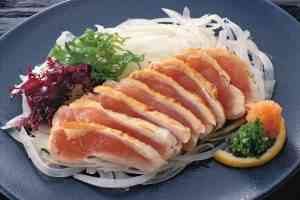A year ago I was in Japan for a few days and my hosts took me for sashimi every night. I think they thought it was funny taking a food safety nerd for a bunch of raw seafood. I did my best to be polite and steered towards more cooked foods. And lots of rice.
Earlier today Sara Miller at Live Science and I exchanged emails about chicken sashimi, a food that has been popular on twitter over the past couple of days. The same food that was linked to 800+ illnesses in the spring of 2016. Even Japanese public health folks were urging against eating it.
It’s not uncommon to find raw foods on a restaurant menu — think sushi or steak tartare — but if you see uncooked poultry as an option the next time you’re dining out, you may want to opt for something else.
Several restaurants in the United States are serving up a raw chicken dish that’s referred to as either chicken sashimi or chicken tartare, according to Food & Wine Magazine. Though the “specialty” hasn’t caught on much in the U.S., it’s more widely available in Japan.
Eating chicken sashimi puts a person at a “pretty high risk” of getting an infection caused by Campylobacter or Salmonella, two types of bacteria that cause food poisoning, said Ben Chapman, a food safety specialist and an associate professor at North Carolina State University.
Chapman noted that eating raw chicken is different from eating raw fish, which can be found in sushi dishes. With raw fish, the germs that are most likely to make a person sick are parasites, and these parasites can be killed by freezing the fish, he said. Salmonella, on the other hand, “isn’t going to be affected by freezing.”
Chicken sashimi is sometimes prepared by boiling or searing the chicken for no more than 10 seconds, according to Food & Wine Magazine.
But these preparations probably only kill off the germs on the surface of the chicken, Chapman said. “But even that I’m not sure about,” he added. In addition, when a chicken is deboned, other germs can get into the inside of the chicken, he said.
